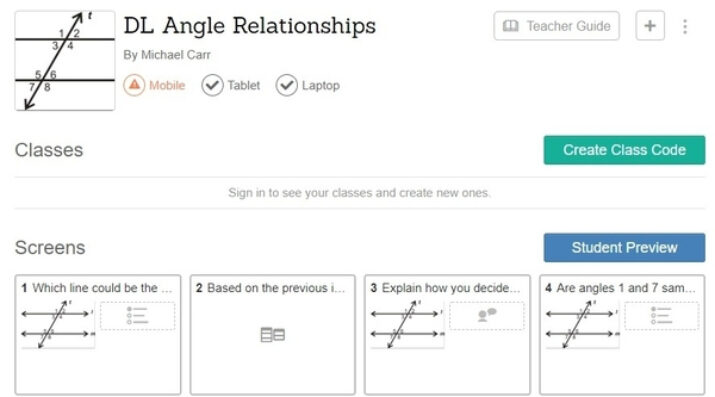New Designs for School
My Secret Weapon for Distance Learning: Accountable, Self-Paced, Mastery-Based Instruction
Topics

We’ve all had the experience of truly purposeful, authentic learning and know how valuable it is. Educators are taking the best of what we know about learning, student support, effective instruction, and interpersonal skill-building to completely reimagine schools so that students experience that kind of purposeful learning all day, every day.
These 4 strategies for measuring—and increasing—student engagement during distance learning build on accountable, self-paced, mastery-based learning experiences.
During this time of social distancing, school systems around the world are scrambling to find a way to make distance learning engaging while maintaining accountability and ensuring that students are mastering content. We need as many resources as possible to provide high quality education to all our students. This post seeks to combine the different strategies I have used to increase engagement during distance learning. I firmly believe that every educator can improve their teaching experience, both remote and in the classroom, by utilizing these strategies.
One of the biggest challenges of distance learning is measuring student engagement through virtual responses. In a physical classroom teachers keep students accountable through prompting and questioning. It is much harder to require a response when we are not sharing a physical space. Relying on worksheets requires students to have access to a printer/scanner, which can present an equity challenge. As a math teacher, I have seen that it is particularly difficult for students to share their calculations unless they have access to a tablet or a way to upload handwritten work. Time constraints may force teachers to move through material even when students are not engaging with and mastering material. Educators need a way to keep students accountable throughout distance learning experiences.
Fortunately, I have been able to navigate distance learning with very little stress because of the work I have been doing with The Modern Classrooms Project throughout the school year. It is a non-profit organization whose core practices are blended instruction, self-pacing, and mastery-based grading. The Modern Classrooms Project has put together a plethora of resources, including an online course, that will give you strategies for effective instruction both in-person and in a distance setting. Personally, this model worked well for me in a classroom setting, when I could frequently check in with students. But I was finding it extremely difficult to frequently check in with students after school closures. I was desperate to find tools that could help to better facilitate the environment of a physical classroom. After looking through a variety of resources, I pulled out four strategies to create a more engaging, distance learning experience. Whichever tools you ultimately choose, these strategies can help keep students engaged and accountable.
Strategy 1: Use a variety of response options.
There are many ways to assess student learning—educators should use a variety to gain a complete picture of student mastery. Educators should ensure that they are using formal and informal assessments. They should also use choice, short answer, and individualized expression to assess what students know. My district is using Google Classroom during our distance learning phase and Google Forms allows you to embed all these types of responses. We are also using a program called Pear Deck, which is a Google extension. It allows teachers to make Google Slides more interactive. Students can write on slides and there are many pre-loaded response options, such as student check-in, which allows educators to gain student data in a variety of ways. I have found it particularly easy to create a multi-faceted assignment with different student response options using Desmos Activities. In my Desmos Angle Relationships activity, for example, response options range from simple multiple choice to organizing a card sort of different concepts or pictures. Try to incorporate a variety of options in order to make the student experience more engaging.
Strategy 2: Create a logical flow by breaking up standards and complex problems into multiple parts.
There are many ways for an educator to break up the standards that their students need to learn. They can start with vocabulary or with a critical thinking question. It may be useful to start with a review of prerequisite content depending on how familiar students are with new content. One way teachers can accomplish this is by using Edpuzzle to create videos and embed questions that will give them an understanding of their students’ strengths and weaknesses. Students can watch the video during their own time, but educators should emphasize that students watch before class not after. With Desmos Activities, educators can scaffold content to whatever degree they need.
I was easily able to create a logical flow in the Dependent Events activity I created in Desmos. This activity focuses on games of chance that involve a standard deck of playing cards. First, I needed to make sure that all students understood the components of a standard deck. Next, I asked my students to define ‘sample space’ to assess their understanding of critical vocabulary. The goal of my activity is for students to calculate the probability of winning the game, but I broke this larger question up into its multiple parts and then had students synthesize and make predictions at the end of the activity. While it helped my students to use this strategy to break the activity into multiple parts, I didn’t need to create a separate slide in Desmos for each individual step. When I asked my students to define ‘sample space,’ for example, I did so verbally because we had covered it in the previous lesson.
Strategy 3: Check mastery frequently.
Mastery checks are short quizzes that break up entire standards into easily measurable objectives. In the Modern Classrooms model, teachers are encouraged to consistently assess student proficiency using mastery checks. This philosophy informs how to design both synchronous and asynchronous learning experiences. During distance learning, teachers can use digital mastery checks or have students upload their handwritten work.
As an example, in Desmos I focused on the same standard throughout the entire activity, but the mastery check slides are where students are showing proficiency of the standard. It might be similar to an assignment where you would check some questions more closely than others. In The Modern Classrooms model we identify “must do,” “should do,” and “aspire to do.” Think of mastery checks as “must dos,” the questions a student would have to complete in order to demonstrate mastery of a standard or objective. Before my next lesson, I sent my students a mastery check Google Form via Google Classroom. This gave me a better understanding of what they had mastered and also served to keep them thinking about the content throughout the week. Having mastery checks will help you evaluate mastery efficiently and will make the distance learning experience smoother.
Strategy 4: Use media and other tools whenever possible.
This step is self-explanatory but extremely important. In order to make the student experience more engaging, media should be utilized whenever possible. In both of my Desmos Activities I included images on almost every slide because it is helpful to have the visual whenever referring to questions. I imagine it would be very helpful for educators in every subject area to add videos and images to enhance student learning. Teachers can use a variety of media options or, like in my activities, focus on one piece of media throughout the entire activity in order to draw attention to a specific concept. If you’d use a visual on your board or slideshow during class, use it during distance learning as well!
BONUS: The Synchronous Session
In a physical classroom, prompting and checking in with students is not difficult to do. Teachers can spend as much or as little time with students as they need. Synchronous learning sessions have proved to be more challenging with regards to engaging and interacting with students. No matter which digital tools a teacher chooses, there are certain “must-haves” that lead to a richer synchronous learning experience.
First, it is very helpful to use a tool that can be easily shared with students. Most of the popular digital platforms, including Pear Deck and Desmos, include a student link that can be posted on your learning management system.
Second, teachers need a way to monitor student responses in real time. Kahoot and Quizlet are popular learning tools where teachers can host live “games” for students. Questions and answer alternatives are displayed on a shared screen while students answer on their devices. Desmos has a teacher dashboard that shows student progress live and can be accessed after the session has ended, making it perfect for synchronous and asynchronous learning. Teachers can also control the pacing of the activity by restricting which slides students have access to.
Finally, teachers need to facilitate collaboration between students. It is important to try to maintain some semblance of social normalcy so that students can continue to develop social skills, even during distance learning. Kahoot allows students to work in teams to share their responses. Pear Deck allows students to write on a shared Google Slides that can be presented to the entire class.
As a teacher in the Modern Classrooms Project, I have had a great deal of experience using blended learning and a self-paced structure to maximize student engagement. One of the biggest challenges during distance learning is engaging students and ensuring that they are mastering content. With these four strategies, you will be able to do this very effectively during distance learning.




